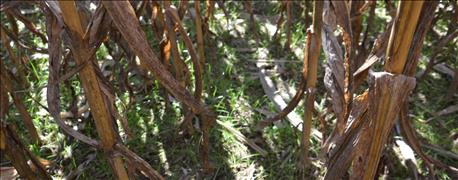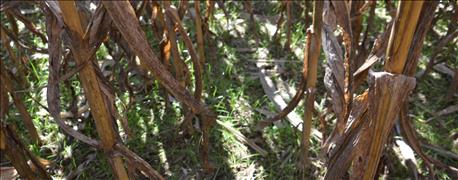
For decades farmers have worked with the Natural Resources Conservation Service, even when it was still the Soil Conservation Service, to develop conservation plans. This has always been the first step to obtaining cost-share assistance for various conservation practices.
The conservation cost-share programs have changed over the years, but the need for a plan has not. District conservationists Don Donovan, Clint Harrison, Brian Musser and Ruth Hackman note that conservation planning is a must if you want to move forward with cost-share programs. Those programs include the Environmental Quality Incentives Program and many others.

GOOD START: This cover crop was off to a good start last fall because Don Zolman, Pierceton, followed a conservation plan. He seeded the cover crop into standing corn.
EQIP allows you and your conservationist to look at all the resource needs of your farm. Then you can draw up a plan and space out practices so you can afford to implement them. There can be substantial cost to you in putting these practices in place, even with cost-share assistance.
This information was prepared by the Indiana Conservation Partnership, led by a team of NRCS personnel including Donovan, Harrison, Musser and Hackman. Other NRCS staff contributing information include Susannah Hinds, grazing specialist; Scot Haley, resource soil scientist; Kris Vance, public affairs specialist; Victor Shelton, state agronomist/grazing specialist; Tony Bailey, state conservation agronomist; and Shannon Zezula, state resource conservationist.
Conservation planning
Many Indiana farmers are managing their farms using a soil health management system of no-till or strip-till, cover crops, adapted nutrient management, and buffers, Donovan says. These farmers are using this system for a variety of reasons, and are seeing tremendous benefits such as reduced erosion, reduced compaction, improved soil organic matter, improved nutrient use efficiency and, ultimately, higher profitability. The conservationists say farmers also see resiliency against weather extremes.
In all cases, each farmer’s specific details of which cover crop species they use each year, their no-till/strip-till planter’s setup and their nutrient management details are specific to their individual fields based on the resource issues they're trying to address, and based on their soils, local climate and crop rotation, Donovan says.
This is the value of a conservation plan, he adds. Through the plan, a conservation professional works one on one with the farmer to identify the variety of resource concerns on that farm. Together, they evaluate various alternative practices and activities that will address these resource concerns.
Each farmer makes the final decision on which system of practices matches his or her operation best. Then, the conservation professional provides the details of each practice to make them successful.
Farm bill participation
Several of these farmers participated in farm bill programs to help them offset costs during their journey to better soil health. In Indiana, each farm bill program participant has a conservation plan that gets developed before the program contract is approved.
If you’re interested in these practices and haven’t implemented them yet, contact your local NRCS office and develop a conservation plan, Donovan says. NRCS can work with you to find the right program that will work best for your farm.
About the Author(s)
You May Also Like




